Treat the sick
Sacrifice, graft and gratitude: How we cared for the victims of the new pandemic
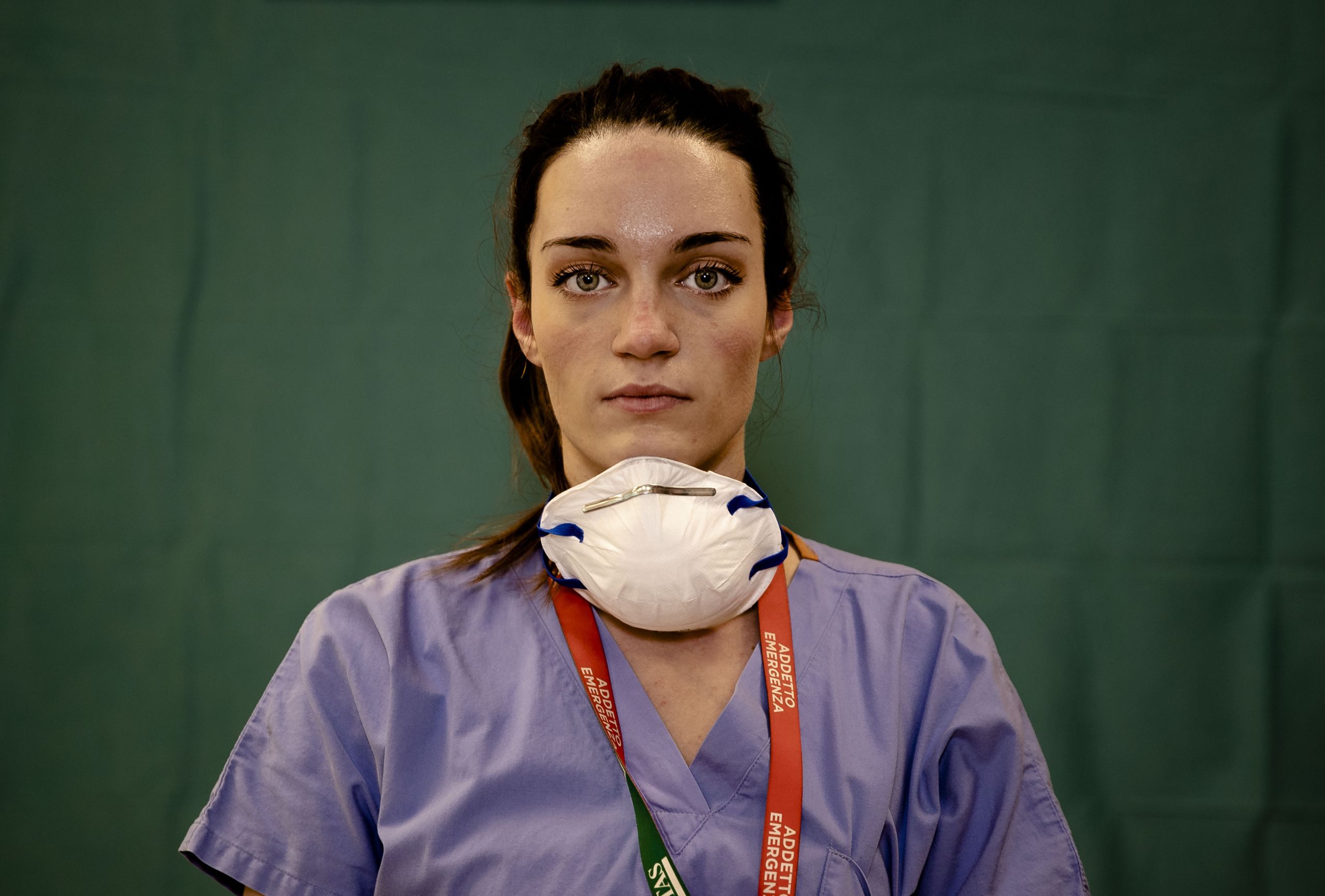
In a pandemic, people get sick. No matter how well the authorities have recognized the problem, understood the disease, minimized the outbreak, communicated the risks and prepared their response, the healthcare system comes under strain. Reducing that strain is perhaps the single most important aspect of pandemic control.
COVID-19 is unusual: not all pandemics will overwhelm healthcare systems around the planet. Most are prepared for seasonal fluctuations in influenza, for example. But the toxic cocktail of communicability, vague symptoms and a long asymptomatic incubation period has made the novel coronavirus one of the biggest threats to global health since the widespread adoption of vaccination, and healthcare systems across the world responded with impressive and sometimes heroic stamina.
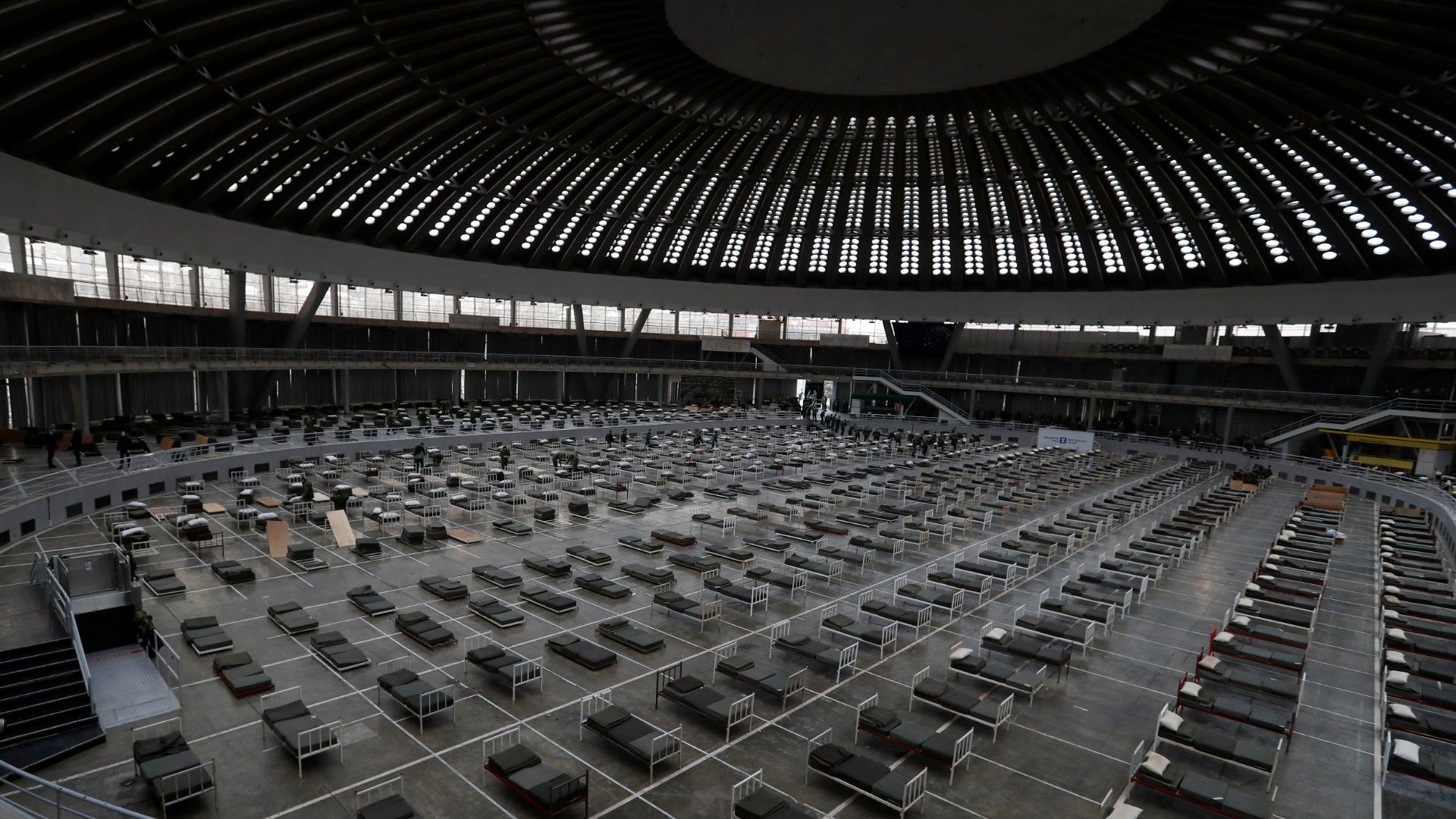
Serbian soldiers set up beds for COVID-19 patients under the dome of the Belgrade Fair. /Darko Vojinovic/AP Photo
Serbian soldiers set up beds for COVID-19 patients under the dome of the Belgrade Fair. /Darko Vojinovic/AP Photo
Increase your capacity

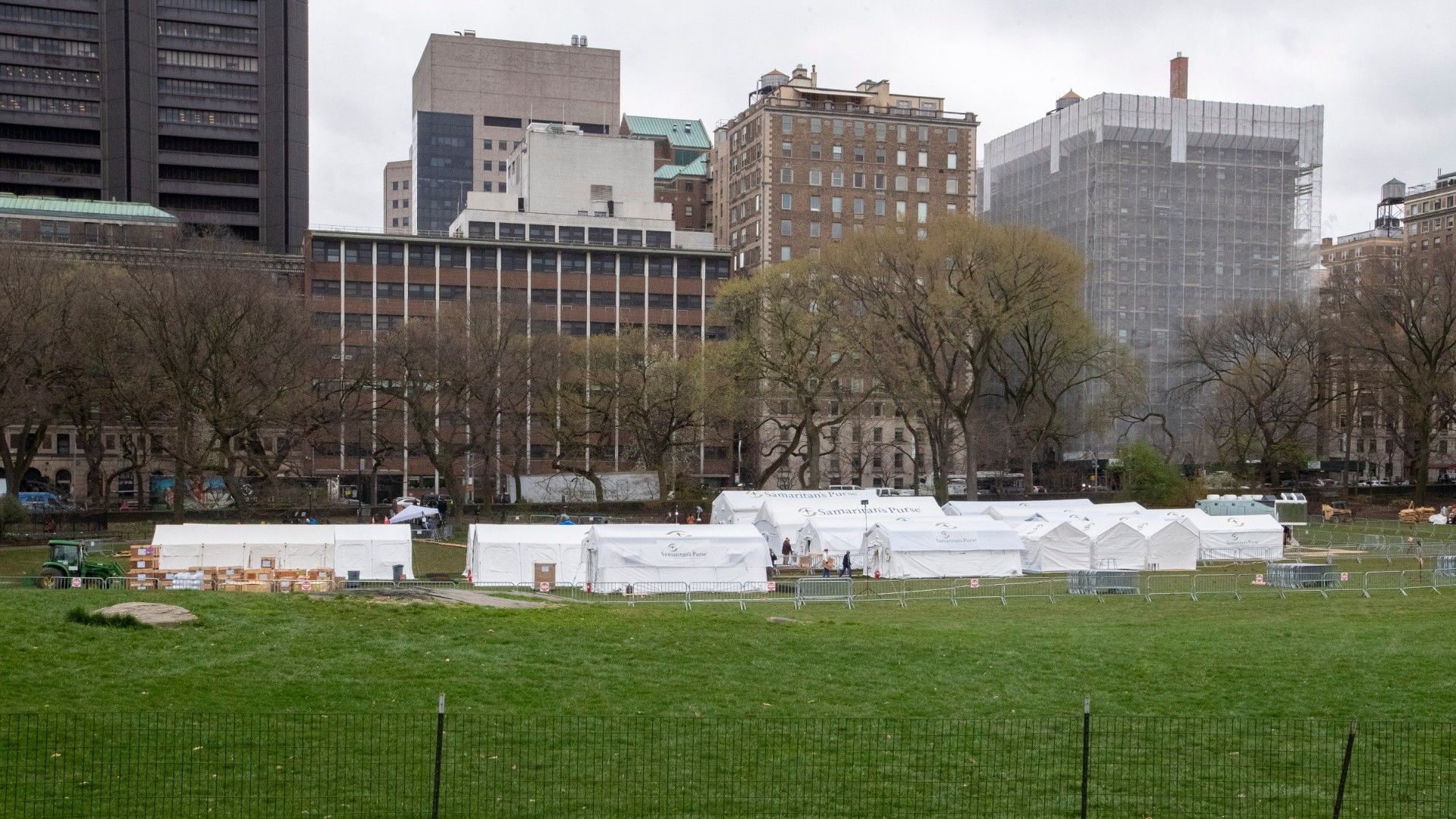
Samaritan's Purse crew prepare an emergency field hospital in New York's Central Park. /Mary Altaffer/AP
Samaritan's Purse crew prepare an emergency field hospital in New York's Central Park. /Mary Altaffer/AP
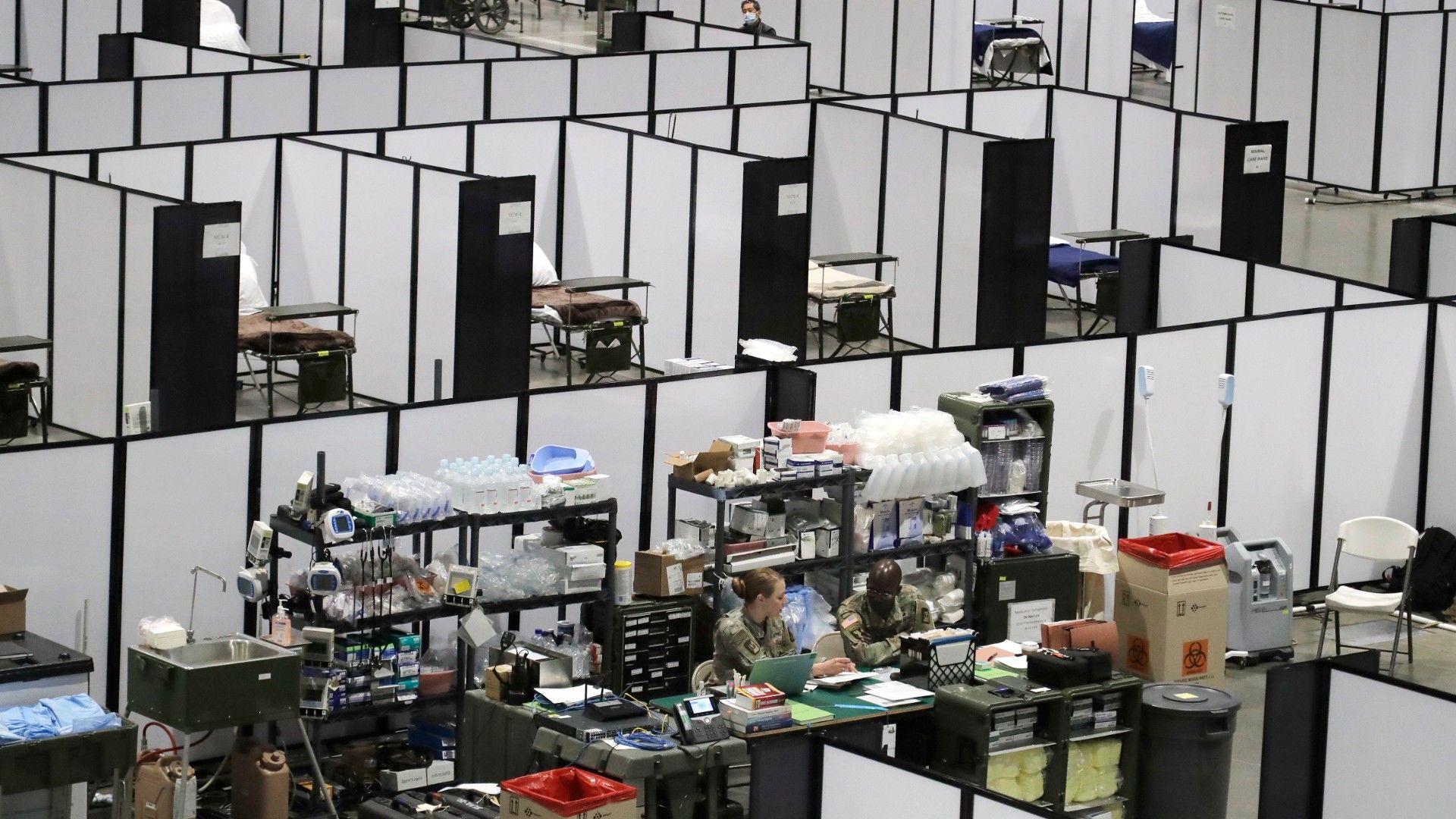
Soldiers work at a nursing station in the intensive care section of a military field hospital at the CenturyLink Field Event Center in Seattle, U.S.. /Ted S Warren/AP
Soldiers work at a nursing station in the intensive care section of a military field hospital at the CenturyLink Field Event Center in Seattle, U.S.. /Ted S Warren/AP
The first concern was one of capacity. As Europe prepared for the full effects of COVID-19, there was much discussion of "flattening the curve" – slowing the outbreak to delay its peak and spread out the cases, to keep the maximum load below the capacity of the healthcare service.
This is entirely understandable and worthy of concern: depending on the severity of a pandemic, health systems may have to treat many times more patients than usual in intensive care units (ICUs) – no matter how well-prepared. On 6 April, a report in The Lancet medical journal noted that "National and regional modeling of needs for intensive care is crucial. Many countries might not have enough ICU beds in the first place, let alone isolation or single rooms."
The Lancet analysis cites one report that the median number of critical-care beds per 100,000 population was 2.3 in 10 low-income and lower-middle-income countries, 4.6 in five upper-middle-income countries, and 12.3 in eight high-income countries in Asia, noting that "Italy, a high-income country with 12.5 critical care beds per 100,000 population, continues to struggle with the outbreak."
The solution was creativity and innovation as countries across the world sought to increase their ability to treat thousands of new and dangerously ill people. Having suffered first, China led the way by building a hospital in Wuhan – the city at the epicenter of the outbreak – within 10 days.
Countries have been inventive in their capacity expansion. In Canada, Montreal's 17th-century Hotel Dieu hospital may be reopened for in-patients to lighten the load. Serbian soldiers set up a makeshift hospital underneath the world's largest pre-stressed concrete dome at the Belgrade Fair.
In Italy, crisis-hit Cremona welcomed the opening of a field hospital by the U.S. religious group Samaritan's Purse, led by the son of evangelist Billy Graham; the same organization later set up a field hospital in New York's Central Park. More prosaically, NHS England block-booked almost the entirety of the private hospital sector's services at cost price "for as long as needed."
But increased capacity has little effect without cooperation. On 28 March, U.S. President Donald Trump waved off the USNS Comfort, a 1,000-bed navy hospital ship, as it set sail from Virginia to aid outbreak-riddled New York City; in its first week there, designated as a non-coronavirus overflow hospital, it treated just 27 patients and was derided by Northwell Health hospital chief Michael Dowling as "a joke."
The Comfort later switched to housing COVID-19 patients, in addition to non-coronavirus cases; the reconfiguration necessary to facilitate this halved its bed capacity.
As the outbreak developed, authorities have had to think laterally to expand capacity. In the UK, the Excel exhibition center was rapidly repurposed as NHS (National Health Service) Nightingale London, specifically for COVID-19 patients – initially 500 beds with the scope to expand to 4,000; for comparison, the country's largest permanent hospital is the 1,677-bed Queen Elizabeth University Hospital in Glasgow.
The first concern was one of capacity. As Europe prepared for the full effects of COVID-19, there was much discussion of "flattening the curve" – slowing the outbreak to delay its peak and spread out the cases, to keep the maximum load below the capacity of the healthcare service.
This is entirely understandable and worthy of concern: depending on the severity of a pandemic, health systems may have to treat many times more patients than usual in intensive care units (ICUs) – no matter how well-prepared. On 6 April, a report in The Lancet medical journal noted that "National and regional modeling of needs for intensive care is crucial. Many countries might not have enough ICU beds in the first place, let alone isolation or single rooms."
The Lancet analysis cites one report that the median number of critical-care beds per 100,000 population was 2.3 in 10 low-income and lower-middle-income countries, 4.6 in five upper-middle-income countries, and 12.3 in eight high-income countries in Asia, noting that "Italy, a high-income country with 12.5 critical care beds per 100,000 population, continues to struggle with the outbreak."
The solution was creativity and innovation as countries across the world sought to increase their ability to treat thousands of new and dangerously ill people. Having suffered first, China led the way by building a hospital in Wuhan – the city at the epicenter of the outbreak – within 10 days.
Countries have been inventive in their capacity expansion. In Canada, Montreal's 17th-century Hotel Dieu hospital may be reopened for in-patients to lighten the load. Serbian soldiers set up a makeshift hospital underneath the world's largest pre-stressed concrete dome at the Belgrade Fair.
In Italy, crisis-hit Cremona welcomed the opening of a field hospital by the U.S. religious group Samaritan's Purse, led by the son of evangelist Billy Graham; the same organization later set up a field hospital in New York's Central Park. More prosaically, NHS England block-booked almost the entirety of the private hospital sector's services at cost price "for as long as needed."

Samaritan's Purse crew prepare an emergency field hospital in New York's Central Park. /Mary Altaffer/AP
Samaritan's Purse crew prepare an emergency field hospital in New York's Central Park. /Mary Altaffer/AP
But increased capacity has little effect without cooperation. On 28 March, U.S. President Donald Trump waved off the USNS Comfort, a 1,000-bed navy hospital ship, as it set sail from Virginia to aid outbreak-riddled New York City; in its first week there, designated as a non-coronavirus overflow hospital, it treated just 27 patients and was derided by Northwell Health hospital chief Michael Dowling as "a joke."
The Comfort later switched to housing COVID-19 patients, in addition to non-coronavirus cases; the reconfiguration necessary to facilitate this halved its bed capacity.

Soldiers work at a nursing station in the intensive care section of a military field hospital at the CenturyLink Field Event Center in Seattle, U.S.. /Ted S Warren/AP
Soldiers work at a nursing station in the intensive care section of a military field hospital at the CenturyLink Field Event Center in Seattle, U.S.. /Ted S Warren/AP
As the outbreak developed, authorities have had to think laterally to expand capacity. In the UK, the Excel exhibition center was rapidly repurposed as NHS (National Health Service) Nightingale London, specifically for COVID-19 patients – initially 500 beds with the scope to expand to 4,000; for comparison, the country's largest permanent hospital is the 1,677-bed Queen Elizabeth University Hospital in Glasgow.
Protect your saviors

"[Healthcare workers] must be tested for the virus and have the PPE they need so that they can carry on their duties without fear for their own safety and that of their families"
Italy has lived through a tragedy that has already cost 20,000 lives. While relatively rich in ICU beds, the country has faced another major resource problem: the decimation of the medical staff to attend those beds, worsened by the lack of sufficient personal protective equipment (PPE).
By mid-March, healthcare workers constituted 9 percent of Italy's COVID-19 cases. Once diagnosed, these victims were removed from front-line service – weakening an already overstretched workforce.
As the International Council of Nurses CEO Howard Catton put it, healthcare workers "must be tested for the virus and have the PPE they need so that they can carry on their duties without fear for their own safety and that of their families."
Catton might have added, without malice, the general public: before being diagnosed, hampered by the lack of protective equipment, these vulnerable heroes were also unwittingly spreading the very virus they were attempting to fight.
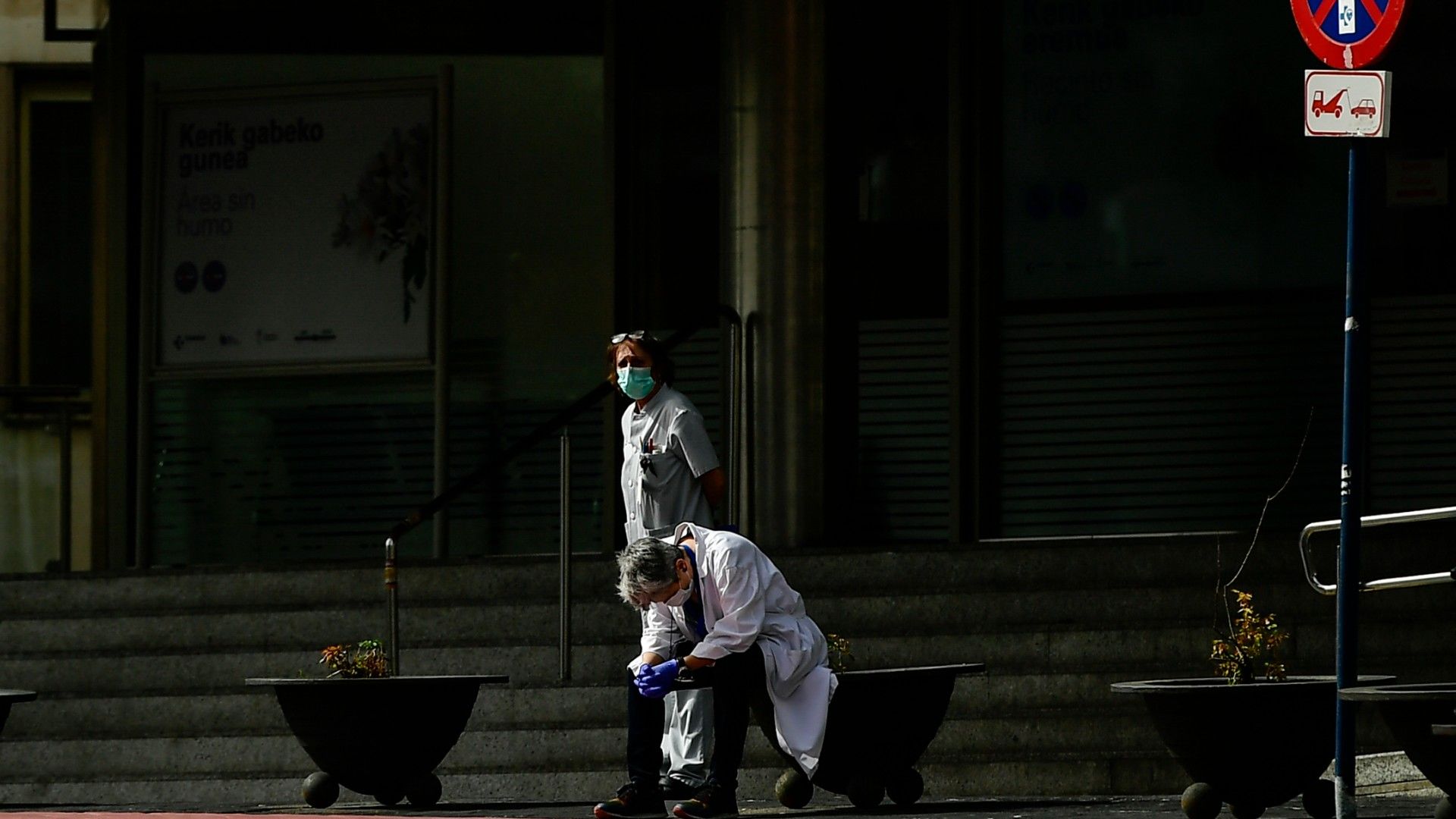
Health workers protest outside the Txagorritxu hospital in Vitoria, northern Spain on 20 March, demanding more protection equipment after a nurse died from COVID-19. /Alvaro Barrientos/AP
Health workers protest outside the Txagorritxu hospital in Vitoria, northern Spain on 20 March, demanding more protection equipment after a nurse died from COVID-19. /Alvaro Barrientos/AP
By 9 April, Italy passed a grim milestone as its 100th doctor died of COVID-19. At that point, an estimated 30 nurses and assistants had also been lost to the disease, it appears that healthcare workers are more likely to die from the disease if they contract it. Besides the human tragedy, there is a worsening logistical problem here: already under severe stress, healthcare services are losing significant numbers of experienced staff forever.
Behind the masks, healthcare workers were fighting the greatest battle of their careers and the public looked on in horror as many paid with their lives. Alongside the danger of going into work, many were also paying a very personal price as they struggled to protect their families at home from getting sick.
As people waited in their homes watching the horror unfold on the news, the sight of their healthcare workers working tirelessly to treat the sick led to frustration at how to reward their heroism. Across Europe, nations came together to show their appreciation in applause.
"[Healthcare workers] must be tested for the virus and have the PPE they need so that they can carry on their duties without fear for their own safety and that of their families"
Italy has lived through a tragedy that has already cost 20,000 lives. While relatively rich in ICU beds, the country has faced another major resource problem: the decimation of the medical staff to attend those beds, worsened by the lack of sufficient personal protective equipment (PPE).

Health workers protest outside the Txagorritxu hospital in Vitoria, northern Spain on 20 March, demanding more protection equipment after a nurse died from COVID-19. /Alvaro Barrientos/AP
Health workers protest outside the Txagorritxu hospital in Vitoria, northern Spain on 20 March, demanding more protection equipment after a nurse died from COVID-19. /Alvaro Barrientos/AP
By mid-March, healthcare workers constituted 9 percent of Italy's COVID-19 cases. Once diagnosed, these victims were removed from front-line service – weakening an already overstretched workforce.
As the International Council of Nurses CEO Howard Catton put it, healthcare workers "must be tested for the virus and have the PPE they need so that they can carry on their duties without fear for their own safety and that of their families."
Catton might have added, without malice, the general public: before being diagnosed, hampered by the lack of protective equipment, these vulnerable heroes were also unwittingly spreading the very virus they were attempting to fight.
By 9 April, Italy passed a grim milestone as its 100th doctor died of COVID-19. At that point, an estimated 30 nurses and assistants had also been lost to the disease, it appears that healthcare workers are more likely to die from the disease if they contract it. Besides the human tragedy, there is a worsening logistical problem here: already under severe stress, healthcare services are losing significant numbers of experienced staff forever.
Behind the masks, healthcare workers were fighting the greatest battle of their careers and the public looked on in horror as many paid with their lives. Alongside the danger of going into work, many were also paying a very personal price as they struggled to protect their families at home from getting sick.
As people waited in their homes watching the horror unfold on the news, the sight of their healthcare workers working tirelessly to treat the sick led to frustration at how to reward their heroism. Across Europe, nations came together to show their appreciation in applause.
Isolate the victims

As governments desperately accelerate their attempts to ameliorate the crisis, most have come to the common-sense conclusion that specialization helps. Logistically, it makes far more sense to have some hospitals focusing on fighting emergencies while others take care of less urgent concerns.
By mid-March, Milan's Ospedale Sacco was already well down this route when CGTN Europe spoke to Maria Rita Gismondo, a director of its laboratory of clinical microbiology, virology and bioemergencies. "Hospitals like ours are mainly focusing on COVID-19 and other emergencies," said Gismondo.
"Patients with scheduled medical checks are being reoriented to other hospitals, which are not treating COVID-19 patients. Other hospitals not equipped for intensive care take care of the daily routine."
As governments desperately accelerate their attempts to ameliorate the crisis, most have come to the common-sense conclusion that specialization helps. Logistically, it makes far more sense to have some hospitals focusing on fighting emergencies while others take care of less urgent concerns.
By mid-March, Milan's Ospedale Sacco was already well down this route when CGTN Europe spoke to Maria Rita Gismondo, a director of its laboratory of clinical microbiology, virology and bioemergencies. "Hospitals like ours are mainly focusing on COVID-19 and other emergencies," said Gismondo.
"Patients with scheduled medical checks are being reoriented to other hospitals, which are not treating COVID-19 patients. Other hospitals not equipped for intensive care take care of the daily routine."
Reduce other stresses

No matter how bad an outbreak gets, other medical emergencies will happen: legs will be broken, babies will be born, cancers will grow. By the end of March, there was evidence in the UK that emergency admissions for some non-coronavirus conditions were falling – perhaps because of increased hygiene, perhaps because they were worried about visiting hospitals overrun with COVID-19 or perhaps because, in the words of UK news magazine Private Eye's medical expert Phil Hammond, "people realize that a paper cut isn't an emergency after all."
Certainly, authorities can to some extent help to ease the pressure on hospitals through clear communications, whether that's advising people to stay away except in the worst emergency or encouraging self-treatment and isolation for mild cases (perhaps suggesting a minimum temperature and a minimum time period to suffer it before going to hospital).
However, as an outbreak ramps up and hospitals approach capacity, difficult decisions have to be made. The UK's NHS has insisted all essential cancer treatment should continue, but chemotherapy can weaken the sufferer's system and render them more vulnerable to COVID-19.
"Everything we do in medicine has a moral underpinning. Given these overwhelming demands, how do I minimize the amount of harm that would otherwise result?"
Partly as a result, the NHS has set up cancer hubs in London and Manchester for urgent surgery, with the aim of isolating cancer patients from the coronavirus as much as is possible. Even so, NHS England has warned that urgent cancer referrals may have to be downgraded "when capacity is particularly constrained," while some hospital trusts have cancelled all outpatient appointments during the outbreak.
It's a heartbreaking but sometimes inevitable part of administering medicine: deciding who to treat and when. As Gismondo told CGTN Europe, "Most of the daily routine has been suspended, in order to free the beds – and the medics – needed to handle COVID-19."
More than ever, hard-pressed healthcare staff need clear triage ethics on who to prioritize. "Everything that we do in medicine has a moral underpinning and we need to be able to justify the decisions that we make," Mark Bratton, an expert on medical ethics and law, told CGTN Europe. "Given these overwhelming demands that are being made on time and resources, how do I – taking into account the whole picture and the constraints that I am working under – minimize the amount of harm that would otherwise result?"
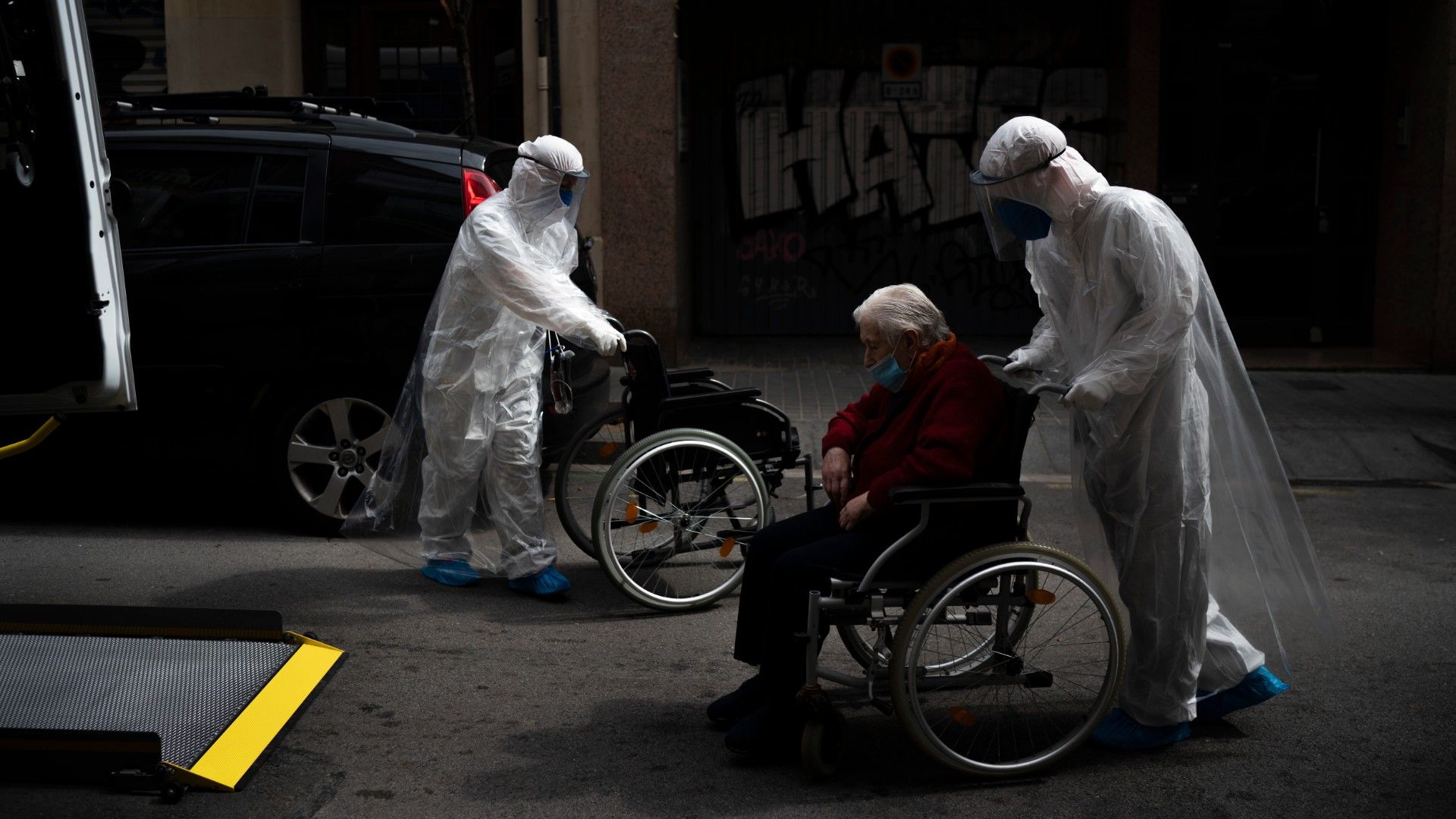
A volunteer of the Spanish NGO Open Arms wheels an elderly resident of a nursing home with coronavirus symptoms to a hospital in Barcelona, Spain. /Felipe Dana/AP Photo
A volunteer of the Spanish NGO Open Arms wheels an elderly resident of a nursing home with coronavirus symptoms to a hospital in Barcelona, Spain. /Felipe Dana/AP Photo
No matter how bad an outbreak gets, other medical emergencies will happen: legs will be broken, babies will be born, cancers will grow. By the end of March, there was evidence in the UK that emergency admissions for some non-coronavirus conditions were falling – perhaps because of increased hygiene, perhaps because they were worried about visiting hospitals overrun with COVID-19 or perhaps because, in the words of UK news magazine Private Eye's medical expert Phil Hammond, "people realize that a paper cut isn't an emergency after all."
Certainly, authorities can to some extent help to ease the pressure on hospitals through clear communications, whether that's advising people to stay away except in the worst emergency or encouraging self-treatment and isolation for mild cases (perhaps suggesting a minimum temperature and a minimum time period to suffer it before going to hospital).
However, as an outbreak ramps up and hospitals approach capacity, difficult decisions have to be made. The UK's NHS has insisted all essential cancer treatment should continue, but chemotherapy can weaken the sufferer's system and render them more vulnerable to COVID-19.

A volunteer of the Spanish NGO Open Arms wheels an elderly resident of a nursing home with coronavirus symptoms to a hospital in Barcelona, Spain. /Felipe Dana/AP Photo
A volunteer of the Spanish NGO Open Arms wheels an elderly resident of a nursing home with coronavirus symptoms to a hospital in Barcelona, Spain. /Felipe Dana/AP Photo
Partly as a result, the NHS has set up cancer hubs in London and Manchester for urgent surgery, with the aim of isolating cancer patients from the coronavirus as much as is possible. Even so, NHS England has warned that urgent cancer referrals may have to be downgraded "when capacity is particularly constrained," while some hospital trusts have cancelled all outpatient appointments during the outbreak.
It's a heartbreaking but sometimes inevitable part of administering medicine: deciding who to treat and when. As Gismondo told CGTN Europe, "Most of the daily routine has been suspended, in order to free the beds – and the medics – needed to handle COVID-19."
"Everything we do in medicine has a moral underpinning. Given these overwhelming demands, how do I minimize the amount of harm that would otherwise result?"
More than ever, hard-pressed healthcare staff need clear triage ethics on who to prioritize. "Everything that we do in medicine has a moral underpinning and we need to be able to justify the decisions that we make," Mark Bratton, an expert on medical ethics and law, told CGTN Europe. "Given these overwhelming demands that are being made on time and resources, how do I – taking into account the whole picture and the constraints that I am working under – minimize the amount of harm that would otherwise result?"
Remove the dead

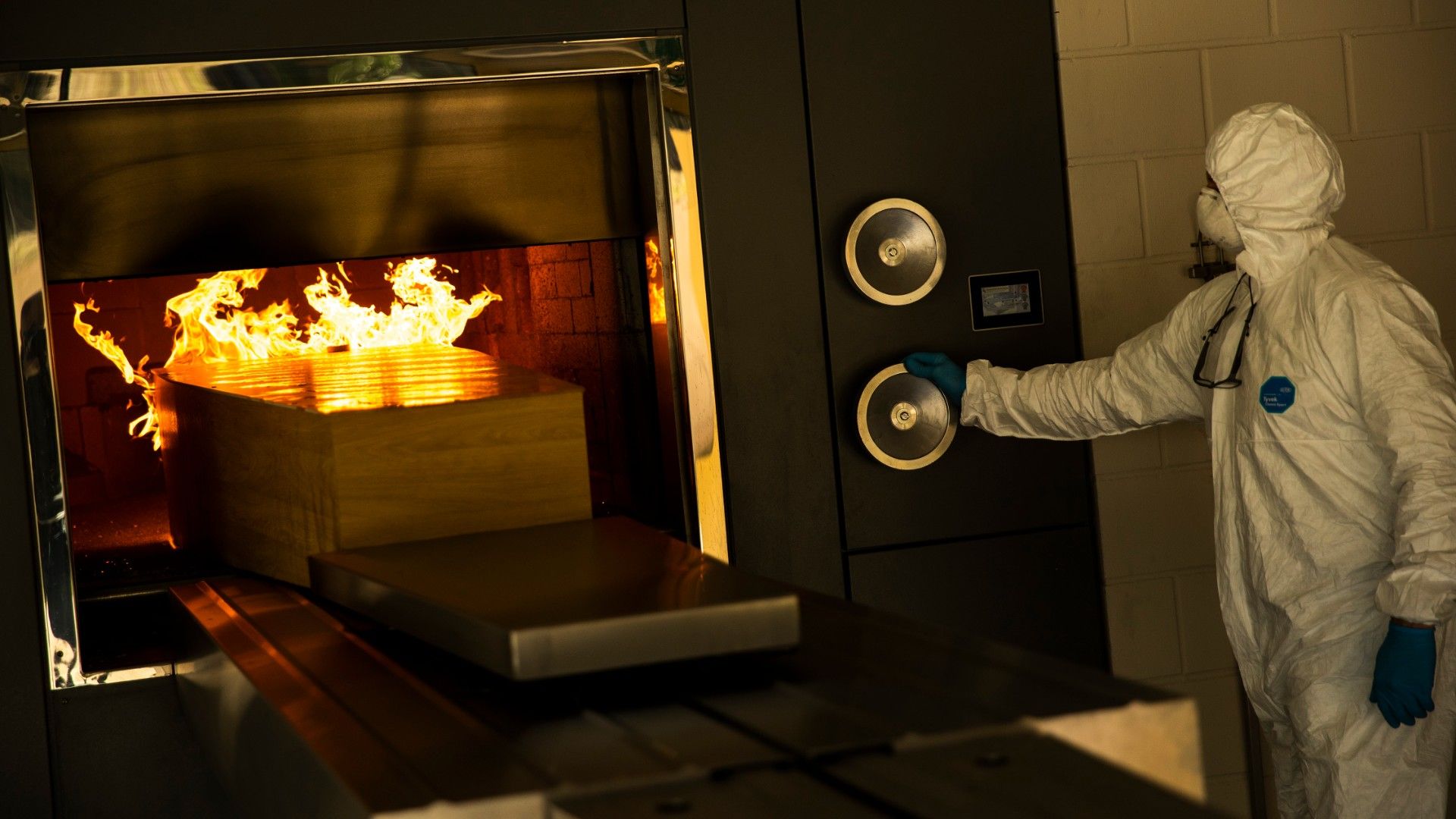
A worker moves a casket of a COVID-19 victim into the oven at the Pontes crematorium in Lommel, Belgium. /Francisco Seco/AP
A worker moves a casket of a COVID-19 victim into the oven at the Pontes crematorium in Lommel, Belgium. /Francisco Seco/AP
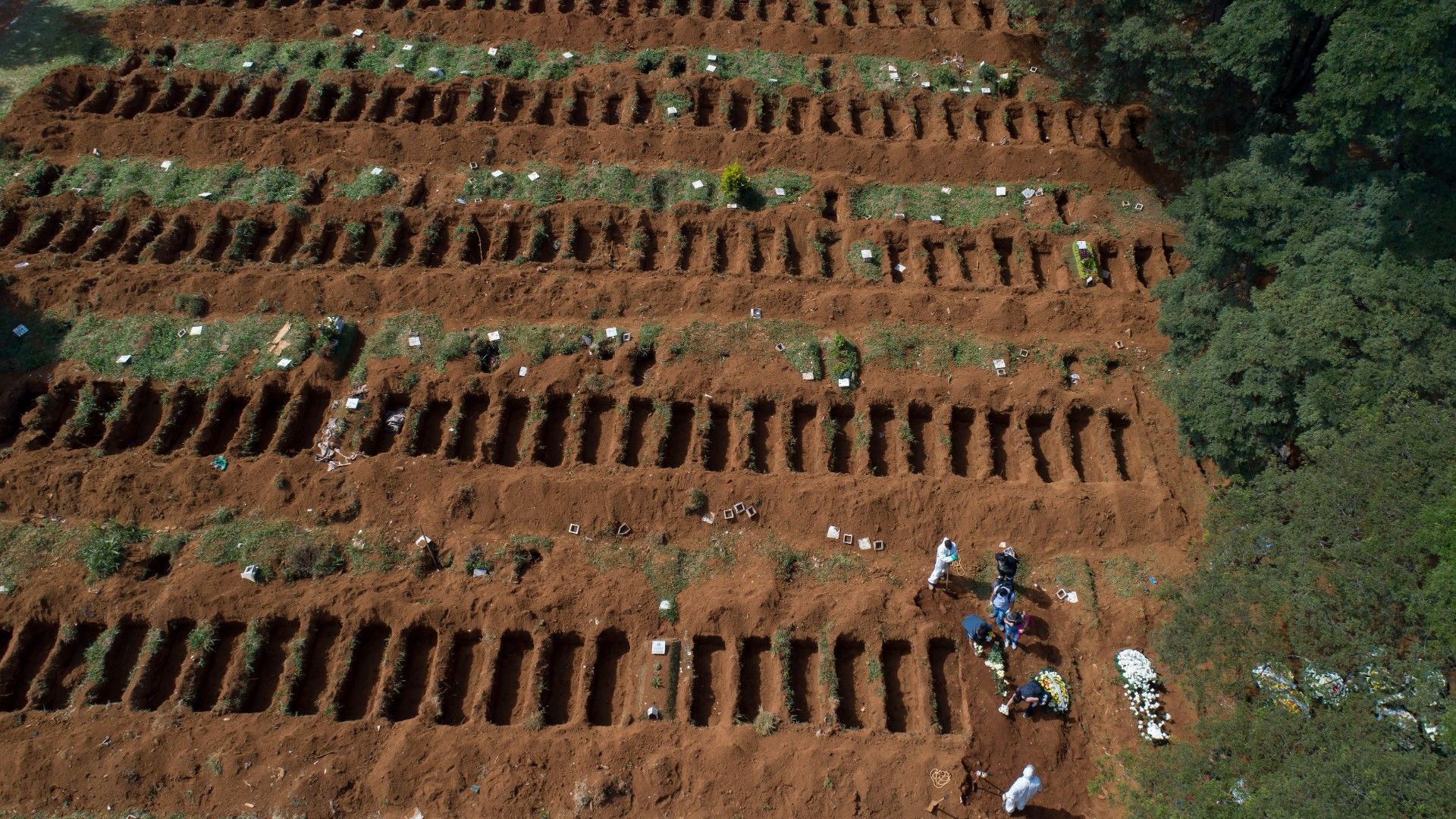
Cemetery workers in protective clothing bury a body at the Vila Formosa cemetery in Sao Paulo, Brazil. /Andre Penner/AP Photo
Cemetery workers in protective clothing bury a body at the Vila Formosa cemetery in Sao Paulo, Brazil. /Andre Penner/AP Photo
Finally, authorities must face the inescapable fact of death and decide how best to deal with those who cannot be saved. This is a logistical and ethical problem. As the virus can survive on clothes for a few hours, corpses are sealed away immediately and grieving relatives are unable to see their loved ones.
Traditional burial practices are curtailed, with many countries banning funeral services. This can negatively affect mental health as families, faced with death, are denied the sociocultural coping mechanisms evolved over centuries.
Through necessity, some societies are changing their methods of grieving, commemoration and celebration. In the Irish county of Kerry, banned from holding the traditional wake or attending the funeral service, parishioners marked one elderly inhabitant's funeral by standing – suitably distanced from one another – alongside the road to the graveyard.
In some places, the sheer number of deaths has overwhelmed the usual niceties hiding the logistics of interment. In Spain's capital Madrid, authorities had to set up a makeshift morgue at the Palacio de Hielo, a large ice rink. In Bergamo, Italy, the cemeteries filled up by the end of March, with bodies transported by a convoy of army trucks to be cremated in other cities.
Such problems are not confined to Europe. From New York, footage emerged of bodies being forklifted into refrigerated trucks and buried in mass graves on an island in the Bronx. In Ecuador, the vice-president had to apologize after corpses were left on streets outside full morgues. The world is facing a large-scale fight against a deadly virus and many will not survive it; what to do with their bodies is just one of the problems that authorities must face.
Finally, authorities must face the inescapable fact of death and decide how best to deal with those who cannot be saved. This is a logistical and ethical problem. As the virus can survive on clothes for a few hours, corpses are sealed away immediately and grieving relatives are unable to see their loved ones.
Traditional burial practices are curtailed, with many countries banning funeral services. This can negatively affect mental health as families, faced with death, are denied the sociocultural coping mechanisms evolved over centuries.
Through necessity, some societies are changing their methods of grieving, commemoration and celebration. In the Irish county of Kerry, banned from holding the traditional wake or attending the funeral service, parishioners marked one elderly inhabitant's funeral by standing – suitably distanced from one another – alongside the road to the graveyard.

A worker moves a casket of a COVID-19 victim into the oven at the Pontes crematorium in Lommel, Belgium. /Francisco Seco/AP
A worker moves a casket of a COVID-19 victim into the oven at the Pontes crematorium in Lommel, Belgium. /Francisco Seco/AP
In some places, the sheer number of deaths has overwhelmed the usual niceties hiding the logistics of interment. In Spain's capital Madrid, authorities had to set up a makeshift morgue at the Palacio de Hielo, a large ice rink. In Bergamo, Italy, the cemeteries filled up by the end of March, with bodies transported by a convoy of army trucks to be cremated in other cities.
Such problems are not confined to Europe. From New York, footage emerged of bodies being forklifted into refrigerated trucks and buried in mass graves on an island in the Bronx. In Ecuador, the vice-president had to apologize after corpses were left on streets outside full morgues. The world is facing a large-scale fight against a deadly virus and many will not survive it; what to do with their bodies is just one of the problems that authorities must face.

Cemetery workers in protective clothing bury a body at the Vila Formosa cemetery in Sao Paulo, Brazil. /Andre Penner/AP Photo
Cemetery workers in protective clothing bury a body at the Vila Formosa cemetery in Sao Paulo, Brazil. /Andre Penner/AP Photo
